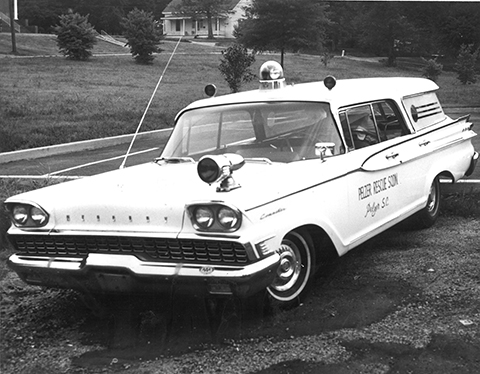By Stan Welch
Just a little less than fifty years ago, if you had a car wreck or a heart attack or any other significant medical emergency in northern Anderson County, you had mighty few choices about how to get to medical care.
You might call Troy Stone’s Garage in West Pelzer and hope Troy could get loose to come pick you up and take you to the hospital; usually Greenville General, which was closest. Or you could call Gray Mortuary if you didn’t mind riding to the hospital in a hearse.
But in 1967 the options began to improve, when the Palmetto CB Club began a long, remarkable transition to what is today a professional, modern and growing rescue squad. The evolution was spurred by the decision of Troy Stone, who operated Stone’s Ambulance Service in West Pelzer, to close down at the end of February of 1967.
The squad began actual full time operations in April of 1967. There were eight volunteers originally. They were Jack Bell,Tommy Odom, Ray Barnwell, Sgt. Bob Poole, Jerry Herd, Tony McAlister, J.D. Whitt, Jack Smith, Ralph Singleton and John Clardy.
Jack Smith was president of the squad, while Ralph Singleton was Captain, and J.D. Whitt and John Clardy were lieutenants. The ambulance was a 1959 Mercury ambulance. By June, the squad had purchased a new Pontiac station wagon, which became the front line vehicle, while the Mercury was placed on backup duty.
Following suit, in March of 1967, a Williamston rescue squad was formed as well. It began operations in May of that year.
Harold Vinson and Joel Jones, two of the Pelzer Rescue Squad’s (PRS) founding members sat down with The Journal several weeks ago to share their recollections of the early days of the Pelzer squad. Current training officer Don Clardy and squad member Bryce Brady joined in with their own reflections on the squad’s current status.
The club started out using a small building near upper mill number 4, with Odell Moon doing the day time dispatching of the emergency calls from his gas station as they came in. The 911 emergency system wasn’t even a dream yet. There was no central dispatch. Law enforcement, fire departments and the rescue squads all had their own separate dispatch. Today, a central dispatch operated by the County simplifies the communications considerably.
The sixteen to twenty early volunteers worked twelve hour shifts. Vinson still remembers sleeping on a pool table in the Pelzer gym. In May of 1967, Whitt replaced Singleton as Captain of the squad, due to health issues.
“In the late Sixties, the mill let us have the old hospital and we built a shed on the front to park the ambulances in,” said Vinson. “In 2000 we opened the second squad on Hwy. 8, and in 2004, we put a squad in at the Powdersville Fire Department, until we moved it to our current location. Then in 2009 we built the squad building here where we are now.”
The Belton Rescue Squad served as the training unit for Pelzer members. Leroy Vinson and current county coroner Greg Shore were among the first class trained in the state of South Carolina, and they helped train others. Vinson, who has since passed away, maintained his certification for more than forty years.
Jones said he was the best paramedic he ever saw. “He stayed calm, he kept patients calm, he kept the rest of us calm, and he knew what he was doing. He was just a natural at it, and the success of this squad is largely because of Leroy.” In recognition of his contributions to the squad, the training room was recently dedicated in Vinson’s name, at a ceremony attended by his family and numerous members of the first responder community.
In the early days, equipment was scarce and usually second hand. “Our medical supplies were pretty basic,” said Jones. “We had some first aid supplies and a stretcher and some splints.”
One of the more unusual cases the squad responded to was the crash of an Air Force fighter jet, an F101. Major Ralph Mayton was on a test flight in November of 1969, following some modifications to the plane, when it lost control and crashed in the Piedmont area. Mayton ejected safely.
The squad responded, with members J.D. Whitt, Odell Moon, W.G. Simmons, Bill Crawford, Randolph Turner and Jerry Farrow. Two members of the Rescue Ladies Auxiliary unit also responded with food and refreshments at the scene.
Beginning in the early Seventies, squad members began pursuing and attaining certification as EMTs, or emergency medical technicians. The law required that at least one EMT be on each truck at all times.
From EMT, the training led to paramedic certification. The County Council and the Appalachian Council of Governments established that program during the Seventies. Clardy pointed out that current training is approaching the level of personnel in emergency rooms. “The squad members just keep climbing that tech ladder. The skills and the training just keep improving.”
The PRS started out using a Mercury station wagon for response and transport. A picture on the wall at the squad building shows a vehicle that Barney Fife would have looked right at home in.
Next came an Oldsmobile hearse and then a Pontiac station wagon. Finally the county gave them a hand me down Chevrolet Suburban. The squad never looked back. Today, the squad has a total of about twenty vehicles, with top of the line ambulances, or trucks as they are called. There are three emergency trucks on duty at all times, while an additional twelve trucks are used in convalescent or non-emergency transport.
Eight are normally in use with four in reserve. They transport patients who receive regular treatment, such as chemotherapy or dialysis, but who are not in an emergency situation.
There are also two rescue vehicles, equipped for serious rescue situations that might have to be resolved in order to provide medical care and transport, such as extraction from a vehicle or rescue from rough terrain or a body of water.
Craig Lawless is the main administrative force within the squad. He said that the squad went from fully volunteer to a transition to a full time, paid unit beginning in 1994.”When we were able to begin billing patients, it enabled us to pay our employees. The convalescent transport aspect gives us a certain stability in our revenues, because most of the services provided are covered by insurance. If someone calls 911, we have to transport and treat, knowing that a fair percentage of those costs will never be recovered. We accept that because it is our duty to respond, but the total operations budget for all three squads is around $4 million a year. It’s a business and we have to take these things into account.”
Today, there are just two volunteers left, and when they leave the squad, volunteers will no longer be recruited. Under today’s regulations, there must be a paramedic on each front line, or emergency response truck. The second member must be at least an EMT. On convalescent runs, an EMT is required but the driver can be a first responder, the lowest training level.
The squad’s coverage area is extensive, and contains approximately forty thousand people in the resident population. Tens of thousands of others move through the area daily on I-85. The squad covers from the Greenville County line to the Pickens County line along Hwy. 8, and from the Greenville County line to the Hwy. 8 exit on the interstate.

















